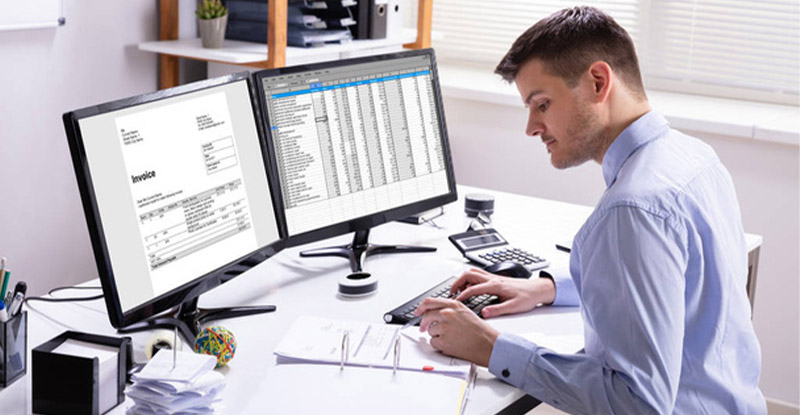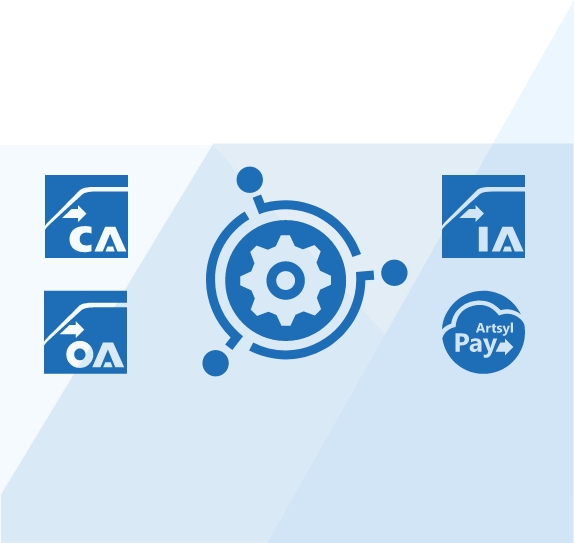In the world of business, time is money, and there is no better way to track and invoice time than using a timesheet. A timesheet invoice is a document used to track time spent on a project or service, which is then used to invoice clients or pay employees.
A timesheet invoice is instrumental in tracking project costs, labor expenses, and invoicing clients in an accurate and timely manner. In this blog, we’ll discuss the importance of a timesheet invoice, how timesheet invoice works, and how to draft a professional timesheet invoice.

Don’t let manual invoicing hold you back
Switch to Artsyl InvoiceAction and automate your timesheet invoice management. Say goodbye to endless spreadsheets and hello to streamlined efficiency. Go ahead and embrace a smarter way to invoice!
Benefits of Timesheet Invoice
Using a timesheet invoice increases transparency between project managers, teams, and clients, and ensures all parties are on the same page. The timesheet allows everyone to see the project’s progress, time spent, and costs incurred. Invoices created from a timesheet create a clear record of time spent on the project, which helps to prevent disagreements and arguments from occurring between you and your clients.
Accuracy and Efficiencies
Creating an accurate timesheet invoice can ensure the smooth running of any project, enhancing efficiency and productivity throughout the process. Time-consuming tasks like tracking time, calculating pay rates, and generating invoices can be automated with a timesheet invoice, eliminating the tedious and prone-to-error manual process.
Thus, timesheet invoice allows project managers to focus on important tasks without having to worry about calculating the payroll or invoicing clients.
Invoice Automation Software
Related Videos
Managing Projects Profitably
One of the most significant advantages of using a timesheet invoice is that it enables businesses to determine profitability on individual projects. By tracking the hours spent on a particular project or service and comparing it with the project’s revenue, you can determine profitability on individual projects.
Profitability analysis can help in identifying high-labor-low-profit, low-labor-high-profit projects, which can be further used to make informed business decisions.
Highlighting Professionalism with Timesheet Invoice
A professional-looking timesheet invoice can make the difference between a satisfied customer and a dissatisfied one. Additionally, timesheet invoices can protect businesses from legal hassles by ensuring tax compliance. When invoices contain all the necessary details, including the name of the customer, the project details, and the amount payable, there is no room for confusion or contention.
Flexibility with Timesheet Invoice
Every business is unique, and the right invoice software will adhere to those unique characteristics. Timesheet invoicing provides businesses the flexibility to choose what’s best for their unique set of requirements. Businesses can determine what functions would be most beneficial to their business based on what type of work they offer, their project management style, and their clients’ invoicing preferences.
In conclusion, a timesheet invoice is an essential tool that can increase transparency, efficiency, and profitability in any business. It enables businesses to track time, calculate payroll, and generate invoices in an accurate and timely way. With the right timesheet software, businesses can manage their projects efficiently while maintaining professionalism and flexibility at all times.
Managing sales orders manually is like juggling with one hand tied behind your back. Unlock the full potential of your business by automating your sales order management with Artsyl OrderAction. Act now for a hassle-free sales order automation experience!
Book a demo now
The Difference Between Freelancer Timesheet Invoice and Employee Timesheet Invoice
The terms «freelancer timesheet invoice» and «employee timesheet invoice» refer to the mechanisms used for billing hours worked but are distinct in their applications, implications, and purposes. Understanding the differences between the two can be crucial for proper accounting, tax considerations, and business management.
Freelancer Timesheet Invoice
- Contractual Obligation: Freelancers typically work on a contractual basis and are not considered employees. Their timesheet invoice serves as a billing document that requests payment for services rendered during a specified period.
- Tax Implications: Freelancers are responsible for handling their own taxes, including income tax and self-employment tax. Therefore, the timesheet invoice does not include tax withholdings.
- No Benefits: Unlike employees, freelancers do not receive benefits like healthcare, retirement contributions, or paid time off from the client. Hence, their invoice focuses solely on the work done and the agreed-upon rate.
- Varied Rates: Freelancers may have different rates for different clients or projects, and this is often reflected in their timesheet invoices.
- Payment Terms: Payment terms such as due dates, late fees, and payment methods are usually clearly stated on the freelancer’s timesheet invoice.
- Limited Liability: As independent contractors, freelancers generally have limited liability and, thus, their timesheet invoices do not contain any employer-employee legal obligations.
Employee Timesheet Invoice
- Part of Employment: Employees fill out timesheets as part of their employment records. These are not invoiced to the employer but are used to calculate salaries or wages.
- Tax Withholding: Taxes, Social Security, and other deductions are automatically withheld from employees’ earnings, and thus, the timesheet serves as a basis for these calculations rather than an invoice for payment.
- Benefits Included: Employees often receive benefits such as healthcare, retirement contributions, and paid time off. Their timesheet records may be used to calculate or track these benefits.
- Consistent Rates: Employees usually have a fixed salary or hourly rate that is consistent across pay periods, reflected in their timesheets but not invoiced per se.
- Payroll System: Timesheets for employees are generally integrated into a company’s payroll system, and payments are processed accordingly.
- Employer Responsibilities: Employers have various legal responsibilities toward employees, including compliance with labor laws, which are not applicable in the context of freelance work.
In summary, while both freelancer and employee timesheets serve to document hours worked, they operate in different contexts with divergent implications for taxation, benefits, and legal obligations. Freelancer timesheet invoices are billing documents sent to clients, whereas employee timesheets are internal documents used for payroll and benefits calculation.
Are you still stuck in the dark ages of manual financial management? Modernize your operations with Artsyl docAlpha and experience real-time payment tracking, automated invoice generation, and so much more. Don’t be left behind; click to elevate your financial processes today!
Book a demo now
How to Create Timesheet Invoice
asCreating a timesheet invoice involves documenting the services provided, including hours worked and tasks performed, and then submitting this information in an invoice format for payment. The process can vary depending on whether you are a freelancer, a small business, or a company with multiple employees. However, the basic principles remain the same. Here are step-by-step guidelines for creating a timesheet invoice:
Step 1: Gather Necessary Information
Collect all pertinent data related to the work done, such as client details, your business information, hours worked, and rates.
Step 2: Choose an Invoicing Method
You can create timesheet invoices manually using word processing software, spreadsheets like Excel, or specialized invoicing software. Each has its pros and cons, so choose one that fits your needs.
Step 3: Create a Header
Your invoice should have a header section that includes your business name, contact details, and possibly a logo. You should also include the client’s name and contact information.
Step 4: Assign an Invoice Number and Date
For tracking and accounting purposes, assign a unique invoice number and date to the document.
Step 5: Detail the Services
Create a table or list that outlines the services provided. This should include a description of tasks, date of service, the number of hours worked, and the rate per hour.
Step 6: Calculate the Total Amount
Multiply the hours worked by the rate per hour for each service or task to find the subtotals. Add up all the subtotals to arrive at the total amount due.
Step 7: Include Taxes and Additional Charges
If applicable, add any taxes or additional charges like late fees or equipment rental costs. Make sure to calculate these accurately.
Step 8: Specify Payment Terms
Indicate the payment terms, including the due date and accepted payment methods, to prevent any misunderstandings or delays.
Step 9: Add a Note or Disclaimer (Optional)
You may wish to include a note or disclaimer to provide further clarification on certain terms or to thank the client for their business.
Step 10: Review and Send
Double-check all the details, including calculations and client information, for accuracy. Once you’re satisfied, send the invoice to your client via their preferred method—email, postal mail, or through an invoicing platform.
If you’re using invoicing automation software, some of these steps can be automated. For instance, software often comes with invoice templates and can auto-fill details, calculate totals, and even send the invoice directly to clients.
By following these steps, you can create a detailed and professional timesheet invoice that clearly outlines the services rendered and the corresponding costs, thereby facilitating a smoother billing and payment process.
Mistakes in invoicing can cost you not just money but also client trust. With Artsyl InvoiceAction, you get unparalleled accuracy in timesheet invoice management, leaving no room for errors. Tap into this fountain of efficiency by taking action today!
Book a demo now
How InvoiceAction Automates Timesheet Invoice Management
InvoiceAction, if it operates like many other automated invoicing and timesheet management solutions, would likely offer a range of features designed to streamline the often tedious and error-prone process of timesheet invoicing. Here’s how InvoiceAction generally automates various aspects of timesheet invoice management:
- Time Tracking: Automated time tracking features can record the time spent on various tasks or projects. Users can often start and stop a timer with a simple click, and the software logs these hours directly into a timesheet.
- Automatic Invoice Generation: Based on the logged timesheets, InvoiceAction can auto-generate invoices that include all the essential details like hours worked, rate per hour, and total amount due. This eliminates the need for manual calculations and data entry.
- Customizable Templates: Users can usually choose from a range of invoice templates or even create their own. These templates can then be automatically populated with the relevant timesheet data, client details, and payment terms.
- Client and Project Management: With built-in CRM features, InvoiceAction allows you to manage client information and project details in one place. You can easily link specific timesheets to respective clients or projects, making invoicing more accurate.
- Tax and Additional Charges: InvoiceAction can be configured to automatically calculate and include any applicable taxes, equipment charges, or other additional fees in the invoice, ensuring compliance with local tax laws.
- Multi-Currency and Multi-Lingual Support: For businesses that operate internationally, automated InvoiceAction often supports invoicing in multiple currencies and languages, automatically handling exchange rates and local tax considerations.
- Scheduled Invoices: You can schedule invoices to be automatically generated and sent at specific intervals, like weekly, bi-weekly, or monthly. This is particularly useful for long-term contracts or retainer-based clients.
- Approvals and Workflow: InvoiceAction includes built-in approval workflows, ensuring that invoices are reviewed and approved by the necessary personnel before being sent to the client.
- Payment Tracking and Reminders: After an invoice is sent, InvoiceAction can automatically track if and when it has been viewed and paid, sending reminders to clients for upcoming or overdue payments.
- Reporting and Analytics: Lastly, InvoiceAction offers robust reporting features, giving you insights into metrics like revenue, outstanding invoices, and even employee productivity.
By automating these various tasks, InvoiceAction enables businesses to focus more on their core operations, while significantly reducing the administrative overhead associated with timesheet invoice management.
Streamline. Automate. Accelerate. These aren’t just buzzwords; they’re your new reality with Artsyl OrderAction. Manage your sales orders effortlessly and free up time for what truly matters — growing your business.
Take the first step now!
Book a demo now
FAQ About Timesheet Invoicing
What is a timesheet invoice?
A timesheet invoice is a document that itemizes the hours worked and tasks completed by an individual or team, usually to request payment for services rendered.
What is a contractor timesheet invoice?
Like a freelancer, a contractor also uses a timesheet invoice to bill clients. However, contractors might have different contractual obligations and tax responsibilities.
What does an hourly rate timesheet invoice involve?
This type of invoice is based on an hourly rate for services rendered. It should detail the number of hours worked and the hourly rate to calculate the total amount due.
What is a project timesheet invoice?
This invoice is often used for billing that covers an entire project. It will still include timesheet data but may also list milestones, deliverables, or even materials costs.
How do I create a timesheet invoice?
You can create one manually using word processors, use specialized invoicing software, or employ templates in spreadsheet programs like Excel.
What is a timesheet invoice template?
It’s a pre-designed layout that helps you create invoices more easily. These templates often include placeholders for details like client information, hours worked, and payment terms.
Can you provide a timesheet invoice example?
A typical example would include a header with the business and client details, a table listing services, hours, and rates, and a footer outlining payment terms.
Is there an Excel timesheet invoice option?
Yes, Excel offers templates specifically for timesheet invoicing. These templates often include automated calculations for totals and taxes.
What timesheet invoice software is available?
There are various specialized software options, some of which offer features like automated invoicing, time tracking, and financial reporting.
You’ve tried the rest, now try the best. Artsyl docAlpha isn’t just another financial management tool; it’s a comprehensive solution for all your intelligent process automation needs. Why settle for mediocrity when excellence is just a click away?
Make the switch now!
Book a demo now
What about automated timesheet invoicing?
Automated invoicing solutions can generate invoices based on logged hours, automatically calculate costs, and even send invoices on your behalf.
Are there cloud-based timesheet invoice solutions?
Yes, cloud-based solutions allow you to manage timesheet invoices from anywhere and often include features like multi-user access and real-time data updates.
Is there a timesheet invoice app?
Yes, there are mobile apps designed to manage timesheet invoicing on the go. These are especially useful for freelancers and small business owners.
How do small businesses handle timesheet invoicing?
Small businesses often use a mix of software and templates to manage timesheet invoicing, taking into consideration their unique needs and budget constraints.
What are billable hours in a timesheet invoice?
Billable hours are the hours worked that will be charged to the client. These should be clearly indicated and differentiated from non-billable hours.
Can I get a timesheet invoice PDF?
Most software allows you to export your invoice as a PDF, which is a widely accepted and secure format for sending documents.
What about customizable timesheet invoices?
Many invoicing platforms offer customizable templates, allowing you to add your branding, specify terms, and even include custom fields.
What is involved in timesheet invoice management?
This includes tracking hours, generating invoices, sending them to clients, and managing payments. Software solutions can automate many of these steps.
Can you describe the timesheet invoicing process?
Generally, the process involves recording time worked, generating an invoice based on this data, adding any additional charges or taxes, and then sending it to the client for payment.



 Interim Invoice: What Is It?
Interim Invoice: What Is It? Your Guide to Commercial Invoices
Your Guide to Commercial Invoices The Basics of an Invoice: The Standard Invoice
The Basics of an Invoice: The Standard Invoice The Ultimate Guide to Final Invoices
The Ultimate Guide to Final Invoices Credit Invoice or Credit Note? Find Out The Difference
Credit Invoice or Credit Note? Find Out The Difference Recurring Invoice: What is It?
Recurring Invoice: What is It?
